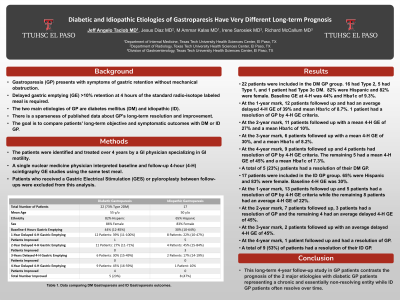Tuesday Poster Session
Category: Functional Bowel Disease
P4056 - Diabetic and Idiopathic Etiologies of Gastroparesis Have Very Different Long-Term Prognosis
Tuesday, October 29, 2024
10:30 AM - 4:00 PM ET
Location: Exhibit Hall E

Has Audio

Jeff Angelo Taclob, MD
Texas Tech University Health Sciences Center
Memphis, TN
Presenting Author(s)
Jeff Angelo Taclob, MD1, Jesus Diaz, MD2, M Ammar Kalas, MD2, Irene Sarosiek, MD3, Richard W. McCallum, MD4
1Texas Tech University Health Sciences Center, Memphis, TN; 2Texas Tech University Health Sciences Center, El Paso, TX; 3Texas Tech University Health Sciences Center El Paso, El Paso, TX; 4Texas Tech University Health Sciences Center School of Medicine, El Paso, TX
Introduction: Gastroparesis (GP) presents with symptoms of gastric retention without mechanical obstruction. Delayed gastric emptying (GE) >10% retention at 4 hours of the standard radio-isotope labeled meal is required. The two main etiologies of GP are diabetes mellitus (DM) and idiopathic (ID). There is a sparseness of published data about GP's long-term resolution and improvement. The goal is to compare the long-term objective and symptomatic outcomes of patients with DM or ID GP.
Methods: The patients were identified and treated over 4 years by a GI physician specializing in GI motility. A single nuclear medicine physician interpreted baseline and follow-up 4-hour (4-H) scintigraphy GE studies using the same test meal. Patients who received a Gastric Electrical Stimulation (GES) or pyloroplasty between follow-ups were excluded from this analysis.
Results: 22 patients were included in the DM GP group. 16 (73%) had Type 2, 5 (23%) had Type 1, and 1 patient had Type 3c DM. 82% were Hispanic and 82% were women. The baseline GE at 4-H was 44% and Hba1c of 9.3%. At the 1-year mark, 12 patients followed up and had an average delayed 4-H GE of 39% and mean Hba1c of 8.7%. 1 patient had a resolution of GP by 4-H GE criteria. At the 2-year mark, 11 patients followed up with a mean 4-H GE of 27% and a mean Hba1c of 10%. At the 3-year mark, 6 patients followed up with a mean 4-H GE of 30%, and a mean Hba1c of 8.2%. At the 4-year mark, 9 patients followed up and 4 patients had resolution of GP by 4-H GE criteria. The remaining 5 had a mean 4-H GE of 45% and a mean Hba1c of 7.3%. A total of 5 (23%) patients had a resolution of their DM GP.<br><br>17 patients were included in the ID GP group. 65% were Hispanic and 83% were women. Baseline 4-H GE was 30%. At the 1-year mark, 13 patients followed up and 5 patients had a resolution of GP by 4-H GE criteria while the remaining 8 patients had an average 4-H GE of 22%. At the 2-year mark, 7 patients followed up, 3 patients had a resolution of GP and the remaining 4 had an average delayed 4-H GE of 45%. At the 3-year mark, 2 patients followed up with an average delayed 4-H GE of 45%. At the 4-year mark, 1 patient followed up and had a resolution of GP. A total of 9 (53%) of patients had a resolution of their ID GP.
Discussion: This long-term 4-year follow-up study in GP patients contrasts the prognosis of the 2 major etiologies with diabetic GP patients representing a chronic and essentially non-resolving entity while ID GP patients often resolve over time.
Note: The table for this abstract can be viewed in the ePoster Gallery section of the ACG 2024 ePoster Site or in The American Journal of Gastroenterology's abstract supplement issue, both of which will be available starting October 27, 2024.
Disclosures:
Jeff Angelo Taclob, MD1, Jesus Diaz, MD2, M Ammar Kalas, MD2, Irene Sarosiek, MD3, Richard W. McCallum, MD4. P4056 - Diabetic and Idiopathic Etiologies of Gastroparesis Have Very Different Long-Term Prognosis, ACG 2024 Annual Scientific Meeting Abstracts. Philadelphia, PA: American College of Gastroenterology.
1Texas Tech University Health Sciences Center, Memphis, TN; 2Texas Tech University Health Sciences Center, El Paso, TX; 3Texas Tech University Health Sciences Center El Paso, El Paso, TX; 4Texas Tech University Health Sciences Center School of Medicine, El Paso, TX
Introduction: Gastroparesis (GP) presents with symptoms of gastric retention without mechanical obstruction. Delayed gastric emptying (GE) >10% retention at 4 hours of the standard radio-isotope labeled meal is required. The two main etiologies of GP are diabetes mellitus (DM) and idiopathic (ID). There is a sparseness of published data about GP's long-term resolution and improvement. The goal is to compare the long-term objective and symptomatic outcomes of patients with DM or ID GP.
Methods: The patients were identified and treated over 4 years by a GI physician specializing in GI motility. A single nuclear medicine physician interpreted baseline and follow-up 4-hour (4-H) scintigraphy GE studies using the same test meal. Patients who received a Gastric Electrical Stimulation (GES) or pyloroplasty between follow-ups were excluded from this analysis.
Results: 22 patients were included in the DM GP group. 16 (73%) had Type 2, 5 (23%) had Type 1, and 1 patient had Type 3c DM. 82% were Hispanic and 82% were women. The baseline GE at 4-H was 44% and Hba1c of 9.3%. At the 1-year mark, 12 patients followed up and had an average delayed 4-H GE of 39% and mean Hba1c of 8.7%. 1 patient had a resolution of GP by 4-H GE criteria. At the 2-year mark, 11 patients followed up with a mean 4-H GE of 27% and a mean Hba1c of 10%. At the 3-year mark, 6 patients followed up with a mean 4-H GE of 30%, and a mean Hba1c of 8.2%. At the 4-year mark, 9 patients followed up and 4 patients had resolution of GP by 4-H GE criteria. The remaining 5 had a mean 4-H GE of 45% and a mean Hba1c of 7.3%. A total of 5 (23%) patients had a resolution of their DM GP.<br><br>17 patients were included in the ID GP group. 65% were Hispanic and 83% were women. Baseline 4-H GE was 30%. At the 1-year mark, 13 patients followed up and 5 patients had a resolution of GP by 4-H GE criteria while the remaining 8 patients had an average 4-H GE of 22%. At the 2-year mark, 7 patients followed up, 3 patients had a resolution of GP and the remaining 4 had an average delayed 4-H GE of 45%. At the 3-year mark, 2 patients followed up with an average delayed 4-H GE of 45%. At the 4-year mark, 1 patient followed up and had a resolution of GP. A total of 9 (53%) of patients had a resolution of their ID GP.
Discussion: This long-term 4-year follow-up study in GP patients contrasts the prognosis of the 2 major etiologies with diabetic GP patients representing a chronic and essentially non-resolving entity while ID GP patients often resolve over time.
Note: The table for this abstract can be viewed in the ePoster Gallery section of the ACG 2024 ePoster Site or in The American Journal of Gastroenterology's abstract supplement issue, both of which will be available starting October 27, 2024.
Disclosures:
Jeff Angelo Taclob indicated no relevant financial relationships.
Jesus Diaz indicated no relevant financial relationships.
M Ammar Kalas indicated no relevant financial relationships.
Irene Sarosiek indicated no relevant financial relationships.
Richard McCallum: Evoke Pharma – Consultant.
Jeff Angelo Taclob, MD1, Jesus Diaz, MD2, M Ammar Kalas, MD2, Irene Sarosiek, MD3, Richard W. McCallum, MD4. P4056 - Diabetic and Idiopathic Etiologies of Gastroparesis Have Very Different Long-Term Prognosis, ACG 2024 Annual Scientific Meeting Abstracts. Philadelphia, PA: American College of Gastroenterology.
